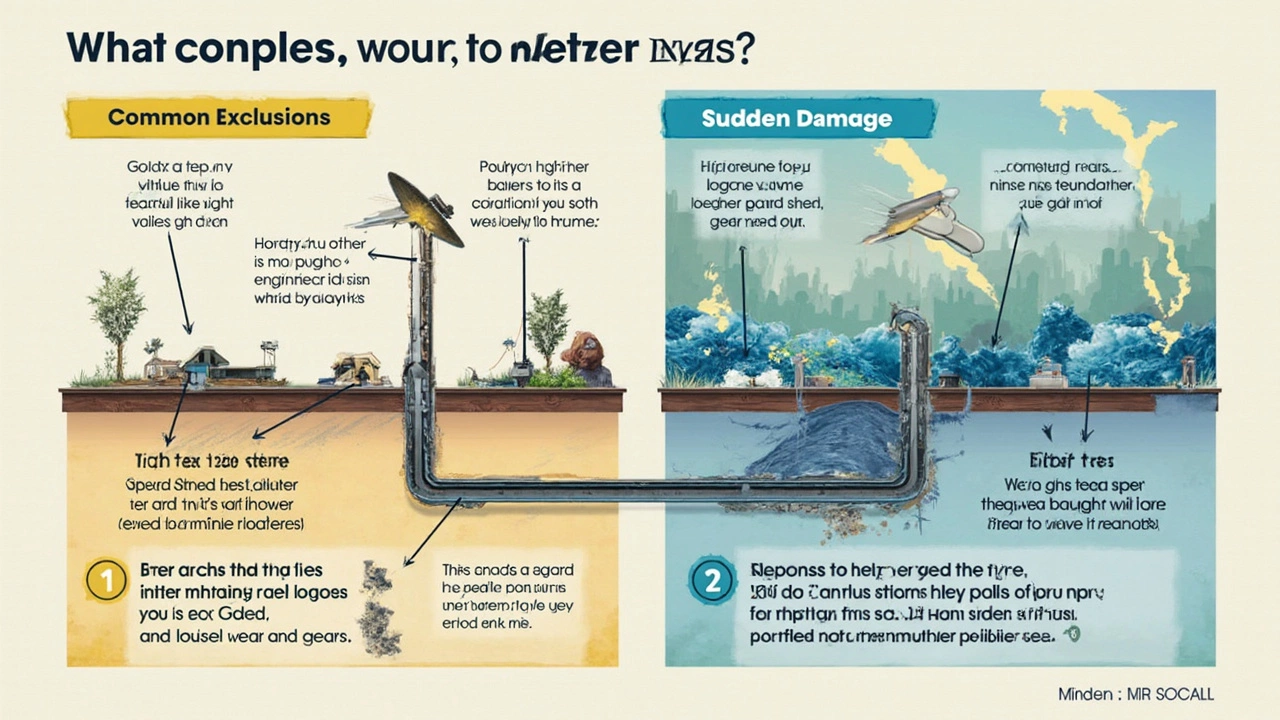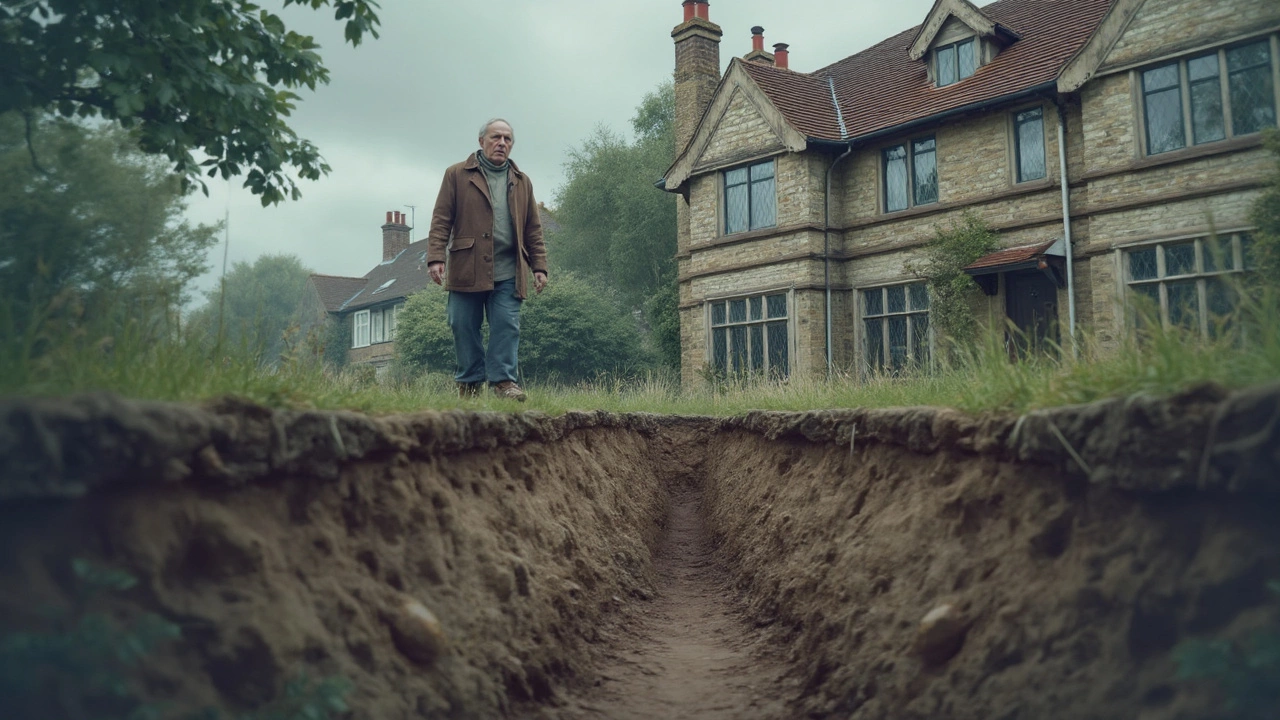Ever felt like your house was giving up on you? Cracks in walls, doors refusing to close, or windows jammed tight—these could be signs of foundation problems lurking under your home. Not exactly the kind of fixer-upper surprise anyone wants. You check your insurance policy, feeling hopeful, only to find that, surprise, surprise, your foundation isn't covered. Yep, it's a bummer.
So, what's the deal? Why don't insurance companies have your back on this one? It's not like you woke up and decided to mess with your foundation, right? Well, the reason mostly boils down to what insurance folks call 'maintenance issues.' You see, stuff like wear and tear or gradual settling usually falls outside the realm of what insurance covers. They see this as something you should maintain on your own, kind of like changing the oil in your car.
But don't lose heart just yet! There's a lot you can do to prevent these problems from getting worse, and some clever tricks might help stretch those dollars further when they do crop up. Stick around, and we'll get into the nitty-gritty of how insurance thinks, why foundation snags aren't generally covered, and ways you can turn things in your favor.
- The Basics of Insurance Policies
- Natural Wear vs. Sudden Damage
- Common Foundation Issues
- Why Repairs Are Often Excluded
- What Homeowners Can Do
- Tips for Foundation Maintenance
The Basics of Insurance Policies
Alright, so you're like most people—insurance policies feel like trying to decode ancient scripts. But hang in there; I'm here to break it down. When it comes to your home insurance policy, it's all about understanding what's under the hood.
Homeowners’ insurance typically covers disasters like fires, hail, tornadoes—a lot of stuff you don't really want happening to your house. But not everything is on the menu. When it comes to foundation repair, insurance usually puts it under 'maintenance issues.' This sneaky little term covers any ongoing wear-down that happens naturally over time.
Insurance sees things like gradual settling or poor initial construction as maintenance issues. Picture this: your foundation starts sinking a bit each year—it's super slow, kinda like watching grass grow. To insurers, that's not their jam to cover. Now, if there's a sudden cause, like an earthquake, that's a whole different ball game.
Here's a quick peek at how insurance categories work:
- Perils Covered: Fire, explosive events, and some sudden disasters and, in flood-prone regions, you might need an extra flood policy.
- Excluded: Earthquakes, floods, termites, and gradual deterioration (aka those pesky foundation issues).
So, it's really about knowing your policy like the back of your hand. A good tip is to sit down with your policy, maybe over a cup of coffee, and highlight anything you're unclear about or ask your agent a ton of questions.
Before you go, here's a mind-boggling stat for perspective: according to some recent data, nearly 30% of U.S. homes will experience some form of structural distress. Yet most of them won't see a dime from their insurance for typical wear-related damage. Understanding these basics helps avoid any unpleasant surprises down the road!
Natural Wear vs. Sudden Damage
Here's the thing: insurance companies have this obsession with separating what they call 'natural wear and tear' from 'sudden damage.' It's like they think they're the relationship counselors of your home's structural problems. But why does it matter? Simple—it affects whether they'll cover the costs or not.
Natural wear and tear is what happens over time. Imagine your foundation like an old pair of shoes—eventually, they're going to wear out no matter how carefully you step. Changes in soil moisture, like long rainy spells or droughts, can make the ground shift over years. This causes gradual settling or minor cracks, which are all part of the natural aging process of a house. Sadly, these gradual changes aren't ticketed items for most insurance claims.
On the flip side, sudden damage is more like getting a flat tire because you ran over a nail—it’s unexpected and immediate. For homes, sudden events like earthquakes, floods, or landslides can cause abrupt and noticeable damage to foundations. The good news? These dramatic events are often covered under specific insurance policies, provided you have them in place. But here's the catch—these policies are usually separate from standard homeowner policies and can cost extra.
The real heartbreaker? Most foundation problems homeowners face stem from the natural wear side of the spectrum. Insurance often classifies them as maintenance issues, which means they're seen as the homeowner's responsibility to fix and prevent through regular upkeep.
So, are your foundation cracks due to natural wear or sudden damage? It can be a tricky question, but understanding these distinctions helps you stay informed about what’s going on with your home and what might be coming out of pocket.
Common Foundation Issues
Let's talk about some of the usual suspects when it comes to foundation headaches. Understanding these can help you pinpoint problems early and maybe save your wallet from some trauma.
Cracks are the most obvious red flags. They can be as sinister as they sound because they might suggest the structural integrity of your home is at risk. A pro tip here? Keep an eye on the size and direction of these cracks. Horizontal or zigzag cracks often spell more trouble than just hairline ones.
Sinking foundations are another common problem. It's like your house is slowly disappearing underground. This usually happens when the soil beneath shifts because of moisture changes or poor compaction during construction. If you notice sloping floors or misaligned doors and windows, you might be seeing the early signs of a sinking foundation.
Then there's water damage. Unwanted water is a sneaky enemy, slipping into cracks and expanding them over time, or worse, leading to mold. Good drainage around your home and fixing leaks can help keep this under control.
"Water is the enemy of many foundations, and proper drainage is key to extending the life of your home," notes Jim Lane, a foundation expert from Home Builders USA.
Poor construction can also cause headaches. Sometimes, the issue isn't what mother nature is doing, but rather what the builders didn’t do right. If the original construction wasn't up to snuff, you might see foundation issues much sooner than expected.
Knowing these issues is half the battle. Spotting them early and taking action can sometimes prevent bigger repairs down the road. And remember, whenever in doubt, it's smart to call in a professional for a detailed inspection before things go from bad to worse.

Why Repairs Are Often Excluded
Alright, so here's the scoop on why foundation repairs usually aren't included under your typical home insurance policy. It often comes down to how insurance companies draw a boundary between sudden, unpredictable events and gradual, expected wear and tear. Most policies are pretty clear about this division. They cover unexpected incidents like fires, storms, or theft rather than the stuff that naturally happens over time.
Imagine your car engine starts making a weird noise after years of driving. You wouldn't expect your auto insurance to cover that, right? That’s kind of a parallel to how insurers view foundation issues. Most foundation repair falls into the maintenance bucket, which means it's on you. Unless a specific, covered event causes the damage—like a tree crashing into your house—those repair costs will likely come out of your pocket.
A big reason for this exclusion is that natural settling and shifting are expected for most homes. It's not something they consider an 'accident.' Plus, there are a ton of factors that can mess with your foundation—poor drainage, tree roots, or even just the type of soil your house sits on. Insuring against these everyday factors would mean sky-high premiums for everyone, and let's face it, no one wants that.
Sometimes homeowners can sneak in a claim if they can convincingly argue that sudden structural changes caused the damage. A friend of mine managed it because a nearby construction project messed with the water table, causing his foundation to crack. But this is more of an exception than the norm.
Bottom line? Insurance firms want to protect against massive, unforeseen events rather than issues that sneak up slowly. Knowing this can help you plan ahead; there’s a reason DIY and proactive home maintenance matter.
What Homeowners Can Do
Facing foundation repairs can feel like you're on a sinking ship, but don't grab the life vest just yet! There's plenty you can do to stay afloat. First and foremost, be proactive with maintenance. A stitch in time saves nine, as they say, and a little upkeep can dodge big headaches down the road.
Word to the wise from a foundation expert, John Stevens:
"Regular checks and simple maintenance today can save thousands in repairs tomorrow. Think of your foundation as the backbone of your home—it needs the occasional adjustment to stay strong."
Let's break it down with some actionable steps that might just rescue your home’s base:
- Regular Inspections: Give your foundation a once-over at least once a year. Check for small cracks, uneven floors, and anything unusual.
- Control Moisture Levels: Too much water can weaken foundations. Make sure your gutters are doing their job by directing water away from your home. Consider installing a sump pump if flooding is an issue.
- Plant Smart: Trees and shrubs are sneaky, with roots that can disrupt foundations. Keep them at a safe distance from your property.
- Address Cracks Promptly: Heard the saying about the mountain from a molehill? Small cracks can become major problems if ignored, so get them fixed sooner rather than later.
If things start getting dodgy, it might be time to get the pros involved. While foundation repair isn't always covered by insurance, some companies offer financing options to ease the blow. Check out local resources and look for customer reviews to find reliable services.
For those keeping an eye on stats, studies have shown that homes with regular maintenance tend to sell for 10% more, giving you more bang for your buck in the long run. So, think of this as an investment in not just your house, but your peace of mind.
Tips for Foundation Maintenance
Keep your house standing tall by giving your foundation some love and attention. Even though insurance isn't always there when cracks appear, a bit of regular care can save you a bundle in the long run.
First off, take a good look around your property. Ensure that the ground around your foundation slopes away from the house. This helps keep water from collecting and seeping into your foundation. An easy fix, right?
Next up, don't underestimate the power of gutters—they should be your best friend. Make sure the gutters and downspouts direct water at least 10 feet away from your home. Regular cleanup is crucial, so don't let leaves and muck accumulate.
Avoid planting trees or large shrubs close to your foundation repair area. Their roots can cause havoc by sucking moisture out of the soil, leading to uneven settling. Who knew plants could be such troublemakers?
- Regularly water the soil around your foundation in dry seasons to reduce the chance of cracks due to soil shrinkage.
- Check for any large trees nearby and consider them for removal if they pose a risk.
- Repair any small cracks early before they grow into bigger issues and bring some DIY plaster into your life.
It's also worth noting what Val Johnson from Home Builders Association says:
"The best foundation maintenance is preventive maintenance. Keeping water away and maintaining consistent soil moisture levels is key."
And hey, sometimes all you need is a professional eye. Hire a pro for a foundation inspection every few years to help spot problems before they become wallet-draining catastrophes. Trust me, it's worth it!
Here's a quick look at average costs associated with preventative maintenance compared to repairs:
| Type of Maintenance | Average Cost |
|---|---|
| Gutter Cleaning | $100 - $200 |
| Downspout Extensions | $20 - $50 |
| Foundation Inspection | $300 - $500 |
| Foundation Repair | $2,000 - $7,000+ |
See what I mean? Prevention definitely pays off. A little effort now, and you'll save yourself a massive headache later. Plus, your home will thank you with years of stable, sturdy service.





